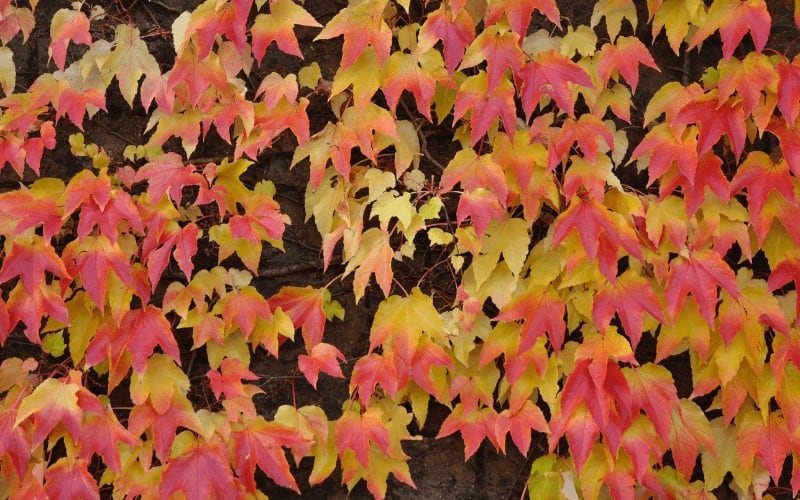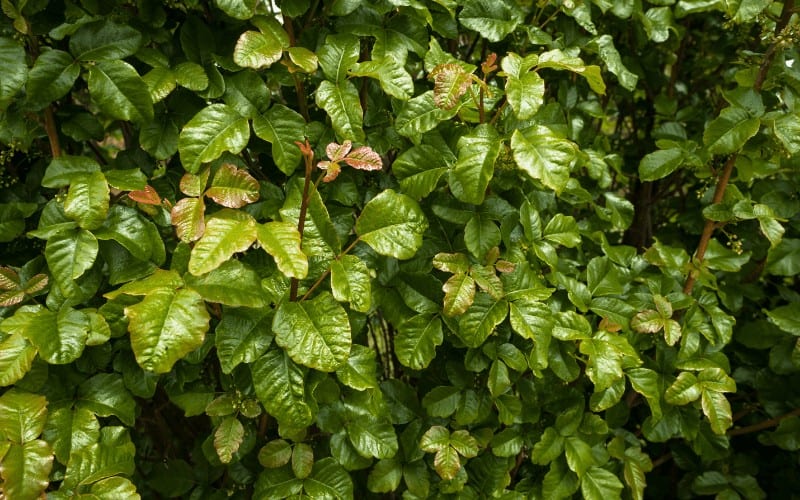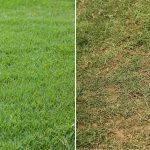You may think differentiating between the Virginia creeper vs poison oak is like trying to tell identical twins apart. But it is not!
In fact, it is incredibly EASIER than you think. One of the quickest ways you can tell is through their leaves. Virginia creeper always has 4 to 5 leaflets on its leaves. Whereas, poison oak has only 3 leaflets.
But that is just the tip of the iceberg. And knowing how to recognize these vines can save you from a miserable red itchy rash.
However, this article on the differences between Virginia creeper and poison oak will fill you in with everything you need to know. But first, let's get to know what each of them is!
Table of Contents
What Is Virginia Creeper?

This Parthenocissus quinquefolia is also known as Virginia creeper is a species of flowering plant in the grape family, Vitaceae.
They are vigorously fast-growing vines that can climb and adhere to (vertical) surfaces with small forked tendrils – attaching with slightly adhesive pads of about 5mm (3⁄16 in) in size.
This care-free plant is a prolific deciduous climber with five-pointed leaves and woody stem, reaching heights of 20–30 m (70–100 ft) in the wild.
Also, it is native to eastern and central North America that produces inconspicuous flowers in late spring; blooms in summer, and bearing fruit in early fall.
Aside from that, Virginia creeper will display brilliant crimson in fall. And continuously drops seeds to the soil until late winter – February.
The seeds or berries are purplish-black of about 5 to 7mm (3⁄16 to 1⁄4 in) diameter. Moreover, these berries maybe look yummy but make no mistakes they contain toxic amounts of oxalic acid and are known for causing kidney damage and death to humans.
Funnily enough, these round ball-like fruits that persist on the vine are a winter food source for many bird species.
Lastly, Virginia creeper offers a wealth of benefits. For example, they are used as a ground cover on slopes and to control soil erosion in shaded areas.
Medicinally, the bark has been used in domestic medicine as a tonic, expectorant, and remedy.
On top of that, the berries are serviceable in rheumatic complaints and are found to help cure dropsy.
So, if you have any intention of planting the Virginia creeper, care should be taken to keep it off wood siding and gutters because the weights could pull off boards and misalign gutters.
What is Poison Oak?

The Toxicodendron diversilobum A.K.A poison Oak is a woody vine or shrub in the sumac family, Anacardiaceae. And it’s one of the gardeners’ most dreaded landscape weeds.
If you have ever experienced the red, itchy, blistery rash that comes from being in contact with this weed, then you will understand the gardeners’ disdain for this plant.
And why is that?
Because the leaves and twigs have a surface oil, called urushiol that causes severe itching and dermatitis to four-fifths of humans on contact. So keep that in mind as you trek into poison oak territory.
Unlike the five-leaved Virginia creeper, poison Oak has only 3 leaflets on its leaves but also turns bright red in autumn/fall as the bush dies back.
Aside from that, poison oak also grows clusters of berries but are white or greenish-yellow that are roughly ¼ inch in size.
The shape of the leaves may be serrated, round, or oak-like depending on what other foliage is around the poison oak plants.
Contrarily to the Virginia creeper, it is a low-growing, upright shrub that can grow approximately 3 feet tall –sometimes giving the appearance of a vine.
The most noticeable difference between the Virginia creeper vs poison oak is that its leaflets have hairs on both sides. Additionally, it may look oily and shiny due to the toxic oil urushiol.
While this weed may not seem valuable to humans, there are surprising benefits of this hearty woodland shrub that has a solid place in the ecosystems. For example:
- The leaves are used to make medicine for treating pain and other conditions.
- It provides a habitat for animals
- It nourishes a wide variety of species
- It competes with invasive species, limiting their spread
Virginia Creeper Vs Poison Oak [Key Differences]
- Virginia creeper is Harmless to the touch. It is not poisonous as poison Oak that causes an itchy rash after contact occurs.
- Virginia creeper’s leaves are thick and have 4 to 5 leaflets with saw-toothed edges. Meanwhile, poison oak has only 3 leaflets.
- Poison oak Does not climb like the Virginia ivy that does with tendrils on ‘host’ trees, shrubs, or nearby items
- Virginia creepers are usually a bigger, more vigorous plant than poison oak, spreading 30-50 feet or more.
- The Virginia creeper bears deep blueberries in the fall. Whereas, poisonous oak has greenish-white berries.
- Virginia creeper vines are thick but poison oak is light with oily surfaces with rough hairs.
You may also wish to read the following topics:
- Herbaceous Plants vs Woody Plants
- Deciduous Trees Vs Coniferous Trees
- Pachysandra Seeds Care
- Lemongrass Vs Citronella Plant
Conclusion
As you can see distinguishing Virginia creeper vs poison oak isn’t as easy as just looking at their leaves.
While both plants offer a wealth of benefits, keep in mind that you must not eat either of their fruits. And avoid making contact with poison oak whenever you see one.




